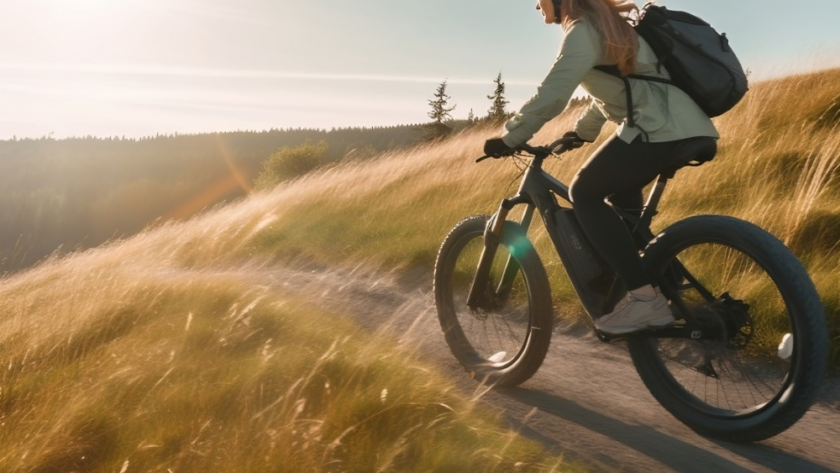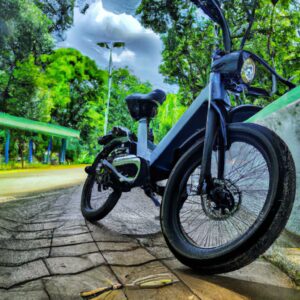Electric Bikes: A Beginner’s Guide
If you’re new to the world of cycling, you may not know that there is actually a type of bike that can be electrically powered. Electric bikes, or e-bikes, have been around for over a century but have recently surged in popularity due to their greater accessibility, efficiency, and fun-factor.
So what exactly is an electric bike?
At their core, electric bikes operate like traditional bicycles but with a battery-powered motor that helps assist the rider in pedaling. The strength and amount of assistance vary depending on the particular model and settings, but the result is a hybrid machine that combines human power and electrical boost.
There are many different types of electric bikes available in the market. One popular subcategory is the “e-mountain bike” which features heavier duty tires and higher suspension to tackle off-road obstacles, including inclines. Alternatively, there are also e-cruisers that have a more sleek, laid-back look and are great for smooth roads, or compact folding e-bikes for easy storage and commuting.
E-bikes come with a variety of features such as multiple speed settings, power-assisted breaks, and LCD displays for monitoring aspects such as speed, distance traveled and battery level. With all of these different options, e-bikes have quickly become one of the most customizable gadgets to go outside with, and the sheer variation available on the market makes shopping for e-bikes both exciting and challenging. Just make sure to do some good research ahead of blowing your wad on just any old model.
In the next section, we’ll explore the mechanics behind electric bikes and how they’re designed to help make uphill cycling easier for riders.
How electric bikes work and help with uphill cycling
Electric bikes, also known as e-bikes, work similarly to traditional bicycles, with the added boost of a battery-powered motor. When you pedal on an e-bike, sensors detect your movement and activate the motor to provide pedal-assisted power, helping you to ride faster and farther than you would on a traditional bike.
The pedal-assist feature of electric bikes is especially useful for tackling uphill terrain. As you pedal, the motor provides more power to assist you in climbing hills. This means you won’t need to put in as much effort to reach the top of each incline, which makes uphill cycling easier and less exhausting.
The level of motor assistance can be adjusted using an e-bike’s controls to match the rider’s preferred pace. For some steep hills, riders can choose to either conserve power by using a low assistance mode that produces less power, or get up the incline faster in a strong mode that provides more powerful assistance.
While electric bikes with average motors produce an effect similar to pushing against headwinds on short inclined road sections representing little resistance, high-end electrical bike designs like full-featured ‘e-mountain bikes’ have adaptive motors that help reduce heavy gravity elements for each footstep.
Overall, the mechanics of electric bikes provide several key benefits, including ease of use, decreased physical strain on the cyclist, reduced commuting time and achieving distances without considerable physical strength. The assistance and energy conservation offered by the motor can make uphill terrain significantly more manageable, whatever your age or fitness level.
Common Problems for Cyclists Uphill
Uphill cycling may seem like the sort of thing that only pro athletes do, but every cyclist who’s ever navigated a hill knows how draining it can be. In addition to fatigue, there are other issues that impact one’s ability to cycle uphill that are not experienced on flat terrain. Some of these common problems are:
- Difficulty breathing: Cycling up hills can mean more exertion than your body is used to and this leads many riders to run out of breath.
- Fatigue: When you’re exerting more energy going uphill, you’re likely to tire out, even if you’re accustomed to daily cycling.
- Lack of motivation: Sometimes a slope just seems too daunting to tackle, which saps the willpower and the enjoyment of the ride.
If you struggle with any of these uphill cycling issues, then an electric bike might be just what you need. An ebike can help decrease these unwanted symptoms by supporting you when pedaling up steep slopes.
Various benefits of electric bikes
If you are setting out on buying a new bicycle, electric ones should top your list as the newest members in bike community. Electric bikes have numerous benefits ranging from boosting physical fitness to ensuring all-around affordability for users.
- Environmental impact: Electric bikes are an eco-friendly means of transportation as they emit zero harmful gases and no fumes.
- Affordability: As compared to cars for assisting with traffic or haul carrying dut [dut? Business? Be specific aboit communication here.), ebikes are more affordable.
- Practicality: With electric bikes assuring regular uphill terrain, you are saved from regular stop/s. The result is a generally faster and smoother mode of cycling maintaining decent speed throughout the ride, particularly with services of premium brands for ebike designs widely available.
- Uphill assistance features: The primary advantage of electric bikes on uphill travel is their superior pedal assistance by motors that guarantee double the power that manual biking can offer
All of these aspects combined suits city dwellers who depend on bicycle assistance from point A to point B. No need for parking pass or waiting taxis. You have the fastest, surest and transport measure of freedom.
Advantages of Electric Bikes for Uphill Cycling
If you’re living in an area with steep inclines, regular cycling can feel like an impossible task. That’s where electric bikes come in. They offer a range of benefits that make uphill cycling much more accessible and enjoyable.
- Effortless Riding: Electric bikes are equipped with a motor that helps propel the bike forward, even up hills. This extra boost of power makes it less challenging to cycling uphill, as the motor does the bulk of the work while you can pedal at a comfortable and relaxed pace.
- Faster Climbs: As you get assistance from the electric motor, you’ll be able to climb hills at a much quicker pace than with a conventional bicycle. This means you’ll spend less time huffing and puffing uphill and cover more distance in less time.
- Extended Range: Given the assistance that electric bikes provide, riders can comfortably take on longer distances without worrying about fatigue or tiring out quickly.
- Better Fitness: The great thing about electric bikes is that the rider still gets a workout despite having assistance from the motor. Regular usage of electric bikes on hilly terrains can result in efficient cardio and strength training exercise, leaving the rider stronger and fitter than ever before.
In conclusion, electric bikes really do offer exceptional advantages to those living in steep, hilly areas who desire to engage in delightful cycling. Transform your uphill cycling game into one with no slopes deep enough!
Best Electric Bikes for Uphill Cycling
If you’re looking to purchase an electric bike that provides excellent uphill support, you should consider designs that have long battery life and powerful motors. Fortunately, there are a growing number of electric bikes being developed specifically for mountain biking and off-road terrain – e-mountain bikes.
- Bulls E-Stream EVO 45 FS – This is a great e-mountain bike with a strong motor that can help support pedaling in difficult uphill terrain. It comes with a high-quality suspension system to offer a comfortable ride while climbing hills.
- Trek Powerfly 9 LT Plus – This e-bike design boasts excellent performance, especially on rugged terrain. The powerful Bosch motor will assist individuals when cycling up steep routes.
- Haibike Xduro Nduro Pro – This electric bicycle is fitted with adjustable shocks to provide enhanced comfort when riding uphill or downhill terrain. The battery life of the Haibike Xduro Pro is another advantage during long hill climbing cycles.
As you can see, several prominent manufacturers have launched motorbikes tailor-made for mountain bike riding to which they offer strong support for tackling brutal altitudes regularly. In case you need to shift heavier loads for more profound and steeper mountains climbing scale stronger e-bikes should be prioritised over others.
FAQs About Electric Bikes for Hill Cycling
Interested in purchasing an electric bike or curious about how electric bikes handle uphill cycling? Check out some commonly asked questions below!
- What is the battery life like on electric bikes?
The battery life on electric bikes varies depending on the manufacturer and model. Generally, they can last 20-60 miles on a single charge, but it is important to keep in mind that the battery may drain faster when cycling uphill than on flat terrain. Make sure to research the battery life of each model you’re considering before making a purchase.
- How heavy are electric bikes?
Electric bikes can be heavier than traditional bicycles due to the added weight of the battery and motor. However, advancements in technology have led to the development of lightweight models that are comparable to standard bicycles. The weight also depends on the type of electric bike you choose (mountain bike, city bike, etc.).
- How much uphill support do electric bikes provide?
Electric bikes are designed to provide assistance when cycling uphill, but each model differs in the level of support provided. Some are equipped with powerful motors and geared specifically for uphill cycling, while others have lighter support for riders who need occasional assistance. Be sure to choose an electric bike that suits your individual needs and preferences.
- Can electric bikes be ridden without pedal assistance?
Yes, electric bikes can be ridden without physical pedaling assistance, but it typically requires substantial energy from the battery. Most electric bikes are designed with pedal assist functions, which means the motor provides support as you pedal, allowing you to exert less energy.
- What makes electric bikes a good choice for uphill cycling?
Electric bikes are a great option for people who live in hilly areas or experience challenges with traditional bicycle climbing. With added motor assistance, electric bikes make it easier to climb steep inclines without demanding too much energy of the rider. Additionally, e-mountain bikes are specifically designed for off-roading and seamlessly ascend rocky terrain.
Preparation Tips for Riding uphill with an electric bike
There’s something magical about biking up a hill and eventually conquering it. We understand this excitement and have compiled some tips to help you prepare before attempting any uphill ride with your electric bike.
- Outfit Right: Wearing the appropriate clothes while riding up a hill will make an exceptional difference in performance. Double-check before leaving for the hills that you’re carrying the appropriate attire according to the weather.
- Pack Some Food: Riding uphill can demand a lot of energy, ensure you’re fueled-up with light, healthy snacks like cut fruits, protein bars. dehydration.
- Carry Drinking Water: The higher the altitude, the more dehydrated you get; Thus drinking water before and during the ride, stays refreshed; therefore, Always carry enough fluids when planning for uphill cycling.
These tips will help you tackle any incline, also ensuring adequate hydration, nutrition, and most importantly, clothing essentials, making the uphill cycle smooth and exciting.
Detail load shifting and other expert means through which electric bicycle can give altitude ease
When riding an electric bike uphill, it’s essential to ensure the bicycle is balanced correctly to avoid exerting too much unnecessary effort and causing strain or fatigue.
One way to do this is by shifting your load before starting your ride up the hill. Distributing the weight evenly over the frame of the bike can give more stability, meaning you can maintain momentum without getting exhausted.
Another expert means of gaining altitude ease is by crushing those challenging hills from their foot. Ideally, many e-bikes come with three gears: low, medium, and high. Therefore, as soon as you start climbing, swap into the lowest gear, and before reaching a hilltop, switch to medium concentrate on efficiently pulling at the pedal stroke before ultimately utilizing high on the descent.
Electric bikes also feature something called pedal assist. Pedal assist is a feature that has caught steam with many e-bike models in the market. When activated, the pedal’s motorized assistance serves to automatically turn the pedals when downward pressure is applied. In such a case, less attention has to go to paddling resulting in smooth and effortless pedaling regardless of terrain.
A crucial tip while riding uphill is to not shy away from tapping on brakes every occasionally if required hence slowing down. Nonetheless, be prepared for a downward speeding frenzy, especially if you choose advanced modes. Under such circumstances, use utmost caution in controlling speed, preferably locating secure positions rotating between standing and sitting back positions, resulting in concerted balance of place involved plus one’s body weight, leaning suits downhill corners preventing gravity tips over accidents that could lead to injury.
In conclusion, electric bikes cater to challenges like sloppy gradients or cruddy work commutes that twenty years old traditional bicycles couldn’t, but applying fundamentals like pedal assists, brake customizations, agility adjustments to climbing up, over heights curtailed steep cycling discomforts that would otherwise produce common problems like strained cycling muscles to an otherwise sluggish speed cycling journey. Ensuring momentum and perfectly selected gear are key components ensuring a seamless ascent.
Emphasize the safety measures during an electric bike uphill ride when speed changes
Riding an electric bike can be safe and enjoyable as long as you are mindful of certain safety measures. When it comes to cycling uphill with the help of an electric bike, stay alert as the bike’s response may vary to the environment. Riders must be cautious in adjusting their speed while going uphill since it can affect the balance of the bike.
- Keep Hands on The Brakes – It’s important to brakes slowly by keeping hands on breaks so that the rider is well-monitored about speed.
- Use Riding Techniques – Using cycling techniques such as deflecting your weight forward or backward regularly, can assist cyclists maintain their grip and avoid any, to loss-overturned uphill.
- Wear the Appropriate Gear – Safety can never go wrong if with suitable safety devices. Always wear a helmet and reflective clothes along with cycling to improve visibility.
- Anticipate Errors – Give extra spaces for things that are unfortetunates; pedestrians unpredictable actions on-foot drivers or uneven rail track – such alerts affect speed uphill movement.
- Safety checks – To further avoid nasty surprise hill conditions while riding uphill, ensure the e-bike chain’s adequacy before sloping uphill arises-by checks tension rating features- to prevent setbacks happening/hardware damages.
Although the mentioned practices may seem demanding, they will enhance security for the riders immensely while pursuing any hilly or inhospitable terraine; cycling safety vouches a confident cycling experience for periods possible.
Real-life examples of electric bikes helping uphill cycling
If you’re still wondering whether electric bikes can really help when it comes to uphill cycling, take a look at some real-life examples from actual riders.
- Jane’s experience: Jane, a senior rider, found that she was increasingly struggling to tackle the inclines on her regular cycling route. “I loved going out on my bike, but my knees just couldn’t cope with the hills anymore,” she says. After doing some online research, she invested in an electric bike and hasn’t looked back since. “The power-assist function has totally transformed my cycling experience and made those nasty hills so much easier,” she enthuses.
- Tom’s experience: Tom, an avid mountain biker, has some harsh terrain to tackle on his regular rides. “Even though I’ve always been reasonably fit, there were some places where I just had to walk because of the steepness,” he says. When he gave an e-mountain bike a go, he found that he could cover more ground without feeling completely exhausted and failure is understood on rough spaces.
- Mike’s experience: Mike was a heavy smoker for almost 20 years before giving up and taking up cycling as part of a health kick in middle age. As a newcomer to the sport (and someone who’d previously hated exercise), he found that high-incline hills were a major hurdle- one that he often couldn’t conquer at all. Nonetheless, after upgrading to an electric bike, he found he was able to power uphill instead of floundering. “It didn’t exactly turn me into a cycling superstar, but I can definitely manage hills better now,” he reports.
As you can see from these case studies, electric bikes really can help make uphill cycling more manageable for right applicants. Of course, everyone’s experience and needs are different, so even if you’re not sure whether an electric bike is right for you, it’s worth doing some research, reading user reviews, or trying different types until you find the best option.
Declining Barriers to Entry through the Affordability of Electric Bikes
Gone are the days when owning an electric bike was the reserve of the affluent members of society. Today, more and more people are enjoying the benefits it offers due to decreased prices, making it almost as expensive or less than buying traditional bikes.
The plummeting reliance on oil, which is the primary source for conventional bicycles coupled with advancements in technology, has led to significant revolutions around manufacturing and the bikes’ pricing mechanisms. A simple online search reveals several sellers offering high-quality electric bikes at reasonable costs hence opening up the market. The increase in the number of producers and sellers ensures consumers have huge numbers to choose from, resulting in increased competition, leading to charge reductions.
The reduction in prices of electric bicycles is an excellent opportunity to introduce more people to healthy living and provide convenience to cyclists transitioning between terrains.
Moving forward, experts are predicting that the increasing embrace of electric biking technology will reduce huge expenses that previously blocked many people from regular exercise riding.
Famous bike manufacturers understand this demand and are dedicating resources to innovations involving improved components empowering increasingly larger segments to experience the health-boosting potential of electric-bicycles.
The future looks electric for cycling industries, sustainable technological development of e-bikes for long haul routes in cities, the establishment of electric charging platforms, cell network infrastructure, and remote locking systems opening each possible phenomenon where cruising will take us– effortlessly locked in on two wheels- roads being no friendly or unfriendly terrain based upon your bike choice alone.
- Ascend hills clumsily no more
- The guarantees for lower barriers to bicycle-ownership grant cyclists twenty first-century ease to travel upwards without working harder. The stability of a safe altitude in an eco-friendly ride have become normal, practical bike design.
Frequently Asked Questions (FAQs) About Electric Bikes for Uphill Cycling
- Q: What are electric bikes?
A: Electric bikes, also known as e-bikes, are bicycles that are powered by an electronic motor which gives support as riders pedal. - Q: How do electric bikes help with uphill cycling?
A: The electronic motor in electric bikes provides diverse levels of assistance that makes riding uphill easier by lessening pedaling discomfort. - Q: What are some common challenges riders face while cycling uphill?
A: Common uphill problems for cyclists consist of issues with breathing, fatigue, and motivation. - Q: What are the advantages of electric bikes compared to traditional, non-electric bicycles?
A: Some benefits of electric bikes include their environmentally friendly qualities, affordability, and practicality as well as special assistive technological features for going up inclines like hills or mountains. - Q: Are there specific designs of electric bikes to consider for uphill cycling?
A: Yes, for maximized support when riding on hilly terrain, it is best to use e-mountain bikes, for example. Samson Kid’s e-Bike & Emergency Refrigerator or VanMoof S3 etc. are some of the top-performing electric bikes designed for this purpose available in the market. - Q. What are some commonly asked questions about electric bikes for hill cycling?
A: Some common questions might include how far the battery will last, the weight of the bike, or how much assistance is provided. - Q: What are some essential preparation tips to consider before uphill riding with electric bikes?
A: Essential preparation tips for uphill cycling with electric bikes include reviewing possible paths on Google Maps, having proper outfit/ protective gear, bringing a packed lunch, staying well-hydrated throughout the ride and gradually shifting loads while climbing These, sure are going to work each time.
comments: 0




